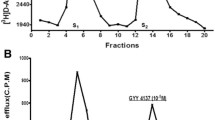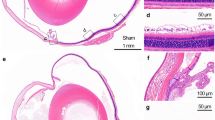Abstract
Hydrogen sulfide (H2S) is a novel gasotransmitter with physiological and pathological functions in vascular homeostasis, cardiovascular system and central nervous system. In the present study, we determined the endogenous levels of H2S in various tissues of the bovine eye. We also examined the basal levels of H2S in response to donors (sodium hydrosulfide, NaHS and sodium sulfide, Na2S), substrate (l-cysteine), inhibitors (propargylglycine, PAG and aminooxyacetic acid, AOA) and activator (S-adenosyl-l-methionine, SAM) of this gas in the bovine retina. H2S was measured using a well established spectrophotometric method. The highest concentration of endogenous H2S was detected in cornea (19 ± 2.85 nmoles/mg protein, n = 6) and retina (17 ± 2.1 nmoles/mg protein, n = 6). Interestingly, H2S was not present in vitreous humor. The inhibitors of CSE and CBS; PAG (1 mM) and AOA (1 mM), significantly attenuated the production of H2S in the bovine retina by 56.8 and 42%, respectively. On the other hand the activator of CBS; SAM (100 μM), H2S donors; NaHS (1 μM) and Na2S (100 μM), significantly increased endogenous levels of H2S in bovine retina. l-cysteine (10–300 μM) produced a significant (P < 0.05) concentration-dependent increase in H2S levels reaching a maximal at 300 μM. We conclude that H2S is endogenously produced in various tissues of the isolated bovine eye. Moreover, endogenous levels of H2S are enhanced in the presence of substrate (l-cysteine), an activator of CBS (SAM) and H2S donors but are blocked by inhibitors of enzymes that synthesize this gas in neural retina.




Similar content being viewed by others
Abbreviations
- H2S:
-
Hydrogen sulfide
- CSE:
-
Cystathionine γ-lyase
- CBS:
-
Cystathionine β-synthase
- PAG:
-
Propargylglycine
- AOA:
-
Aminooxyacetic acid
- SAM:
-
S-adenosyl-l-methionine
- NaHS:
-
Sodium hydrosulfide
- Na2S:
-
Sodium sulfide
References
Qu K, Lee SW, Bian JS et al (2008) Hydrogen sulfide: neurochemistry and neurobiology. Neurochem Int 52:155–165
Lowicka E, Beltowski J (2007) Hydrogen sulfide (H2S) - the third gas of interest for pharmacologists. Pharmacol Rep 59:4–24
Tan BH, Wong PT, Bian JS (2010) Hydrogen sulfide: a novel signaling molecule in the central nervous system. Neurochem Int 56:3–10
Tay AS, Hu LF, Lu M et al (2010) Hydrogen sulfide protects neurons against hypoxic injury via stimulation of ATP-sensitive potassium channel/protein kinase C/extracellular signal-regulated kinase/heat shock protein 90 pathway. Neuroscience 167:277–286
Li L, Moore PK (2007) An overview of the biological significance of endogenous gases: new roles for old molecules. Biochem Soc Trans 35:1138–1141
Erickson PF, Maxwell IH, Su LJ et al (1990) Sequence of cDNA for rat cystathionine gamma-lyase and comparison of deduced amino acid sequence with related Escherichia coli enzymes. Biochem J 269:335–340
Stipanuk MH, Beck PW (1982) Characterization of the enzymic capacity for cysteine desulphhydration in liver and kidney of the rat. Biochem J 206:267–277
Swaroop M, Bradley K, Ohura T et al (1992) Rat cystathionine beta-synthase. Gene organization and alternative splicing. J Biol Chem 267:11455–11461
Hosoki R, Matsuki N, Kimura H (1997) The possible role of hydrogen sulfide as an endogenous smooth muscle relaxant in synergy with nitric oxide. Biochem Biophys Res Commun 237:527–531
Levonen AL, Lapatto R, Saksela M et al (2000) Human cystathionine gamma-lyase: developmental and in vitro expression of two isoforms. Biochem J 347(Pt 1):291–295
Lu Y, O’Dowd BF, Orrego H et al (1992) Cloning and nucleotide sequence of human liver cDNA encoding for cystathionine gamma-lyase. Biochem Biophys Res Commun 189:749–758
Meier M, Janosik M, Kery V et al (2001) Structure of human cystathionine beta-synthase: a unique pyridoxal 5’-phosphate-dependent heme protein. EMBO J 20:3910–3916
van der Molen EF, Hiipakka MJ, van Lith-Zanders H et al (1997) Homocysteine metabolism in endothelial cells of a patient homozygous for cystathionine beta-synthase (CS) deficiency. Thromb Haemost 78:827–833
Yap S, Naughten ER, Wilcken B et al (2000) Vascular complications of severe hyperhomocysteinemia in patients with homocystinuria due to cystathionine beta-synthase deficiency: effects of homocysteine-lowering therapy. Semin Thromb Hemost 26:335–340
Abe K, Kimura H (1996) The possible role of hydrogen sulfide as an endogenous neuromodulator. J Neurosci 16:1066–1071
Richardson CJ, Magee EA, Cummings JH (2000) A new method for the determination of sulphide in gastrointestinal contents and whole blood by microdistillation and ion chromatography. Clin Chim Acta 293:115–125
Gadalla MM, Snyder SH (2010) Hydrogen sulfide as a gasotransmitter. J Neurochem 113:14–26
Persa C, Osmotherly K, Chao-Wei Chen K et al (2006) The distribution of cystathionine beta-synthase (CBS) in the eye: implication of the presence of a trans-sulfuration pathway for oxidative stress defense. Exp Eye Res 83:817–823
Pong WW, Stouracova R, Frank N et al (2007) Comparative localization of cystathionine beta-synthase and cystathionine gamma-lyase in retina: differences between amphibians and mammals. J Comp Neurol 505:158–165
De Luca G, Ruggeri P, Macaione S (1974) Cystathionase activity in rat tissues during development. Ital J Biochem 23(6):371–379
Kraus JP, Kozich V (2001) Cystathionine B synthase and its deficiency. In: Carmel R, Jacobsen DW (eds) Homocysteine in health and disease. Cambridge University Press, Cambridge, pp 223–243
Mudd SH, Levy HL, Kraus JP (2001) Disorders of trans-sulfuration. In: Scriver CR, Beaudet AL, Sly WS, Valle D, Childs B, Kinzler K, Vogelstein B (eds) The metabolic and molecular bases of inherited disease. McGraw-Hill, New York, pp 2007–2056
Kulkarni KH, Monjok EM, Zeyssig R et al (2009) Effect of hydrogen sulfide on sympathetic neurotransmission and catecholamine levels in isolated porcine iris-ciliary body. Neurochem Res 34:400–406
Monjok EM, Kulkarni KH, Kouamou G et al (2008) Inhibitory action of hydrogen sulfide on muscarinic receptor-induced contraction of isolated porcine irides. Exp Eye Res 87:612–616
Opere CA, Monjok EM, Kulkarni KH et al (2009) Regulation of [3H] D-aspartate release from mammalian isolated retinae by hydrogen sulfide. Neurochem Res 34:1962–1968
Ohia SE, Opere CA, Monjok EM et al (2010) Role of hydrogen sulfide production in inhibitory action of l-cysteine on isolated porcine irides. Curr Eye Res 35:402–407
Njie-Mbye YF, Bongmba OY, Onyema CC et al (2010) Effect of hydrogen sulfide on cyclic AMP production in isolated bovine and porcine neural retinae. Neurochem Res 35:487–494
Xia M, Chen L, Muh RW et al (2009) Production and actions of hydrogen sulfide, a novel gaseous bioactive substance, in the kidneys. J Pharmacol Exp Ther 329:1056–1062
Kimura H (2010) Hydrogen sulfide: from brain to gut. Antioxid Redox Signal 12:1111–1123
Eto K, Ogasawara M, Umemura K et al (2002) Hydrogen sulfide is produced in response to neuronal excitation. J Neurosci 22:3386–3391
Eto K, Kimura H (2002) A novel enhancing mechanism for hydrogen sulfide-producing activity of cystathionine beta-synthase. J Biol Chem 277:42680–42685
Eto K, Asada T, Arima K et al (2002) Brain hydrogen sulfide is severely decreased in Alzheimer’s disease. Biochem Biophys Res Commun 293:1485–1488
Finkelstein JD, Kyle WE, Martin JL et al (1975) Activation of cystathionine synthase by adenosylmethionine and adenosylethionine. Biochem Biophys Res Commun 66:81–87
Jensen KK, Geoghagen NS, Jin L et al (2011) Pharmacological activation and genetic manipulation of cystathionine beta-synthase alter circulating levels of homocysteine and hydrogen sulfide in mice. Eur J Pharmacol 650:86–93
Cheng Y, Ndisang JF, Tang G et al (2004) Hydrogen sulfide-induced relaxation of resistance mesenteric artery beds of rats. Am J Physiol Heart Circ Physiol 287:H2316–H2323
Li L, Bhatia M, Zhu YZ et al (2005) Hydrogen sulfide is a novel mediator of lipopolysaccharide-induced inflammation in the mouse. FASEB J 19:1196–1198
Szabo C (2007) Hydrogen sulphide and its therapeutic potential. Nat Rev Drug Discov 6:917–935
Qingyou Z, Junbao D, Weijin Z et al (2004) Impact of hydrogen sulfide on carbon monoxide/heme oxygenase pathway in the pathogenesis of hypoxic pulmonary hypertension. Biochem Biophys Res Commun 317:30–37
Pan TT, Feng ZN, Lee SW et al (2006) Endogenous hydrogen sulfide contributes to the cardioprotection by metabolic inhibition preconditioning in the rat ventricular myocytes. J Mol Cell Cardiol 40:119–130
Fiorucci S, Antonelli E, Distrutti E et al (2005) Inhibition of hydrogen sulfide generation contributes to gastric injury caused by anti-inflammatory nonsteroidal drugs. Gastroenterology 129:1210–1224
Morrison ML, Blackwood JE, Lockett SL et al (2008) Surviving blood loss using hydrogen sulfide. J Trauma 65:183–188
Author information
Authors and Affiliations
Corresponding author
Rights and permissions
About this article
Cite this article
Kulkarni, M., Njie-Mbye, Y.F., Okpobiri, I. et al. Endogenous Production of Hydrogen Sulfide in Isolated Bovine Eye. Neurochem Res 36, 1540–1545 (2011). https://doi.org/10.1007/s11064-011-0482-6
Accepted:
Published:
Issue Date:
DOI: https://doi.org/10.1007/s11064-011-0482-6




